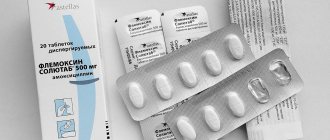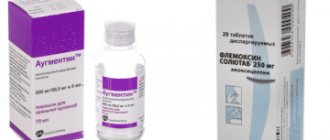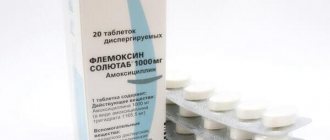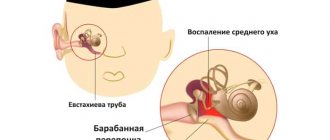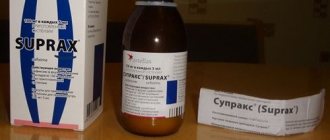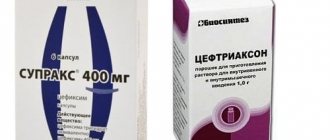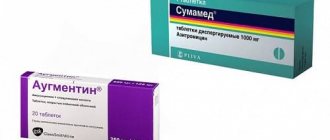The most effective antibacterial drugs
In each clinical case, the most effective antibiotics for bronchitis are different, since the causative agents of the disease can vary greatly. Sputum culture, which accurately identifies the causative agent of the pathology, will help you choose the right drug. What antibiotics to prescribe for bronchitis should be determined by your doctor.
He has several groups of antibacterial drugs at his disposal:
1. Penicillins supplemented with clavulanic acid. The following are popular: Augmentin, Panclave, Amoxiclav.
2. Macrolides. Popular drugs in this group: Sumamed, Claricin, Erythromycin.
3. Fluoroquinolones. Prescribed when penicillins and macrolides do not justify themselves. The following drugs are used: Avelox, Rotomox, Moxifloxacin.
4. Cephalosporins. They are used in the treatment of the obstructive form of the disease, administered parenterally. They have proven themselves well: Ceftriaxone, Thornaxon, Rocephin.
When choosing antibiotics for bronchitis, doctors take into account the patient’s age, frequency of exacerbations, severity of bronchial obstruction syndrome and the presence of concomitant diseases.
Uncontrolled use of antibiotics contributes to the formation of resistance in bacteria to their action.
Augmentin or Suprax: which is better and what is the difference (differences in composition, reviews from doctors)
Augmentin or Suprax - both drugs are antibiotics, their active ingredients are different.
Characteristics of Augmentin
Augmentin is classified as a penicillin antibiotic. But its composition is somewhat more complicated. The medicine is a combination drug that includes an antibiotic and clavulanic acid, which fights microorganisms that are resistant to penicillins and cephalosporins.
Augmentin or Suprax - both drugs are antibiotics, their active ingredients are different.
Amoxicillin is an effective antibiotic. But it is susceptible to destruction by enzymes produced by pathogenic microorganisms.
Clavulanic acid acts as an inhibitor of these enzymes; it inactivates them, which makes it possible to fight those microbes that are resistant to amoxicillin.
The action of the drug is directed against the following bacteria:
- gram-positive aerobic organisms, including Bacillus anthracis, some types of streptococci and staphylococci (including aureus), as well as Enterococcus faecalis, Listeria monocytogenes and others;
- gram-negative aerobic microorganisms, including gastritis-causing microbes Helicobacter pylori, Haemophilus influenzae, Vibrio cholerae and others;
- some gram-positive and gram-negative anaerobic bacteria, including peptococci and Clostridium spp.;
- other pathogenic microbes, including Leptospira icterohaemorrhagiae.
The spectrum of antibacterial action of the drug is wide. However, there are a number of bacteria that are resistant to the combination of amoxicillin and clavulanic acid. These are, for example, corynebacteria, some streptococci, including Streptococcus pneumoniae, Klebsiella, Shigella, Escherichia coli, Salmonella, etc.
Augmentin is classified as a penicillin antibiotic.
Augmentin release forms are film-coated tablets. They contain various excipients - magnesium stearate, microcrystalline cellulose.
The film shell itself contains titanium dioxide, macrogol and dimethicone. These tablets are produced in two dosages - 375 and 625 mg. For children, an analogue is produced in the form of a suspension.
Augmentin is manufactured by the British company GlaxoSmithKline.
Characteristics of Suprax
The drug is produced in the form of soluble tablets and capsules. Its active ingredient is cefixime, a third-generation antibiotic from the cephalosporin group. 1 capsule contains 400 mg of this substance.
Cefixime itself is resistant to enzymes that destroy penicillin antibiotics.
It is active against gram-positive (streptococci) and gram-negative bacteria, including Klebsiella, Shigella, Salmonolella, and Escherichia coli, which are resistant to penicillin antibiotics. But clostridia and most staphylococci are resistant to cefixime.
One of the forms of release is capsules.
Comparison of Augmentin and Suprax
The drugs have similarities and differences.
Similarities
Although both drugs belong to different groups of antibiotics, the indications for use will be the same:
- Infectious diseases of the upper and lower respiratory tract, including tonsillitis, otitis media, sinusitis, lobar pneumonia, exacerbations of chronic bronchitis (characteristic symptoms are attacks of dry cough). An important condition is that drugs are used only if it is established that the diseases are caused by microbes sensitive to them.
- Uncomplicated genitourinary tract infections, including cystitis, pyelonephritis and urethritis.
- Infectious skin diseases caused by Staphylococcus aureus and some types of streptococcus.
- Inflammatory diseases of the joints, if it is proven that their causative agents are staphylococci.
In addition, Augmentin can be used in the treatment of a disease such as gonorrhea, but only in this case high doses of the drug are prescribed.
Both medications require a dosage. When determining it, body weight is taken into account. For example, Suprax in capsule form is prescribed to adolescents weighing more than 50 kg, 1 capsule per day (400 mg of active ingredient).
Both drugs have side effects, and they are the same. For example, this is an allergic reaction: runny nose, urticaria, angioedema, etc. With long-term use of antibiotics, dysbacteriosis is possible, including candidiasis of the skin and mucous membranes. There may be gastrointestinal disorders, including nausea, diarrhea, vomiting, etc.
Augmentin and Suprax negatively affect the liver, but this is a common problem when using any antibiotics, including the macrolide group.
Side effects of Suprax, in addition to those listed, are interstitial nephritis, headaches and dizziness.
Both drugs can be used during pregnancy, but only if the potential benefit outweighs the possible harm. This also applies to the period of breastfeeding.
Which is cheaper?
A package of Suprax containing 7 capsules costs 800-900 rubles, and the price of Augmentin is 300-400 rubles. depending on the dosage (375 and 625 mg).
Which is better: Augmentin or Suprax
In this case, there is no clear answer to the question of which is better. When treating respiratory diseases, it is imperative to do a sputum test in the throat to determine the causative agent of the disease.
Augmentin and Suprax are active against the same types of microbes. But there are a number of bacteria that are resistant to the active ingredients of Augmentin, so the decision in each case is made by the doctor.
If there are symptoms of sinusitis, then Augmentin is most often prescribed, since this disease is caused by bacteria that it fights.
There is not always time to determine the type of pathogen. But if there are symptoms of sinusitis, then Augmentin is most often prescribed, since this disease is caused by bacteria that it fights.
Signs of sinusitis are characteristic green snot and pain in the paranasal sinuses. For diagnosed pneumonia, Suprax is prescribed. Concomitant diseases must also be taken into account. For example, if you have diabetes, Augmentin is better tolerated.
For children
The selection rules described above work for adults, who tolerate antibacterial drugs better and have higher immunity; in pediatrics, the approach will be somewhat different.
When treating a child, it is not so much the novelty of the chosen antibiotic that matters, but the rationality of its prescription. Sometimes even the resistance of pathogens can be overcome by simply increasing the dose of the drug, but in pediatrics this method has limitations.
Studies have shown that during infectious processes in the respiratory organs of children, sensitivity to Augmentin is 94-100% (depending on the strain of bacteria).
Sensitivity to cefixime and other antibiotics from the cephalosporin category is only 85-99%. That is, these are less effective means.
Given that Suprax has more side effects, Augmentin is most often used in pediatrics.
For children, the drug is prescribed in the form of a suspension. The manufacturer also produces a powder from which antibacterial drops are made. These two dosage forms are better accepted by the child's body.
Patient reviews
Anastasia, 39 years old, St. Petersburg: “The doctor prescribed Augmentin for bronchitis to prevent the development of pneumonia. It didn’t help, because there was pneumonia after all, and it had already been treated with Suprax. Both antibiotics were well tolerated; there were no allergies to either.”
Stanislav, 42 years old, Vladivostok: “I take Augmentin for exacerbations of chronic bronchitis. Although they believe that Suprax is more effective, there is an allergic reaction to it, but not to Augmentin.”
Names of tablets that can be taken for bronchitis
Many patients are interested in the names of antibiotics for bronchitis in adults in tablets. Some try, based on the experience of others, to choose their own treatment. But still, in order to avoid serious consequences, it is better to leave this prerogative to specialized specialists.
Azithromycin
For bronchitis in adults, Azithromycin is often prescribed. The drug contains an active substance with the same name, which belongs to the macrolides from the azalide group. The spectrum of its action is quite wide. It is produced by various Russian pharmacological companies.
Sumamed
Another popular antibiotic for bronchitis is Sumamed. This is a bacteriostatic antibacterial agent containing azithromycin. It is produced in Croatia. This is a more expensive analogue of domestic Azithromycin. The course dose of the drug is 1.5 g. Take it 1 hour before or 2 hours after a meal.
Augmentin
For bronchitis, Augmentin can be prescribed. The drug contains amoxicillin and clavulanic acid. The presence of the latter protects amoxicillin from destruction by beta-lactamases. Thanks to this, the spectrum of action of Augmentin significantly expands. The antibiotic is produced in the UK.
Solutab Flemoxin
The Netherlands produces the drug Flemoxin Solutab, used for bronchitis. It contains amoxicillin (semi-synthetic penicillin). The tablet is swallowed whole, chewed or pre-dissolved in water to form a syrup/suspension.
Suprax
Suprax is also used for bronchitis. It contains cefixime, a semi-synthetic antibiotic from the group of third-generation cephalosporins, which has a bactericidal effect. The tablet is swallowed with a glass of clean water, or a suspension is prepared from it and immediately drunk. The drug is produced in Italy.
Biseptol
For bronchitis in adults, Biseptol is often prescribed. This is a combination antimicrobial drug consisting of sulfamethoxazole and trimethoprim. It immediately fights a large list of microbial agents. Take Biseptol orally after meals. The dose is prescribed individually. Biseptol is produced in Poland.
Zinnat
The antibiotic Zinnat is also popular for bronchitis. It contains cefuroxime, an antibacterial agent from the group of second generation cephalosporins with a bactericidal effect. For optimal absorption, it is recommended to take the drug after meals. Zinnat is produced in the UK.
Comparison of Suprax and Flemoxin Solutab
There are similarities between the drugs, but there are still more differences.
Similarities
The mechanism of action of both drugs is aimed at stopping the vital activity of bacterial cells. Both medications are offered in oral dosage forms.
Antibiotics have similar indications, contraindications and side effects. Medicines are prescription drugs.
What is the difference
The difference between the drugs is as follows:
- release forms - Suprax has more of them;
- group of drugs - Flemoxin is a representative of penicillins, and Suprax is a cephalosporin;
- active ingredients - Suprax is produced on the basis of cefixime, and Flemoxin is based on amoxicillin;
- Suprax has more contraindications and side effects.
You can buy Flemoxin Solutab for 230 rubles. for 20 tablets with a dosage of 125 mg.
Which is cheaper?
The cost of drugs depends on the dosage, the number of tablets in the package, and the form of release. You can buy Flemoxin Solutab for 230 rubles. for 20 tablets with a dosage of 125 mg. The price of 6 capsules of Suprax with a dosage of 400 mg is about 720 rubles, granules for suspension are about 590 rubles.
Complex of 3 tablets
For a course of treatment for bronchitis in adults, 3 antibiotic tablets are sufficient if macrolides-azolides were chosen. Medicines containing azithromycin:
· Azibiot (Slovenia);
· Z-Factor (Russia);
· Ziromin (Türkiye);
· Sumamed (Croatia);
· Sumamox (India);
· Hemomycin (Serbia).
All of them are sold in 3 tablets containing 500 mg of active ingredient. Take them once a day for 3 days in a row. Do this 1 hour before or 2 hours after meals. Despite the fact that antibiotics for bronchitis should not be officially sold without a prescription, most often they can be purchased over the counter at any pharmacy.
Characteristics of Suprax
An antibiotic that has 2 release forms - tablets and granules intended for preparing a suspension. Pharmacological group: cephalosporins. The active substance is cefixime.
Suprax is prescribed for damage to the urinary system.
The mechanism of action is to stop vital processes occurring in the cells of pathogenic microflora due to the destruction of cell membranes by the main substance. Without the opportunity to develop, grow and reproduce, pathogens die.
Indications for use of Suprax:
- infectious diseases of the upper respiratory tract - bronchitis (acute and chronic), sinusitis, pharyngitis, otitis media, tonsillitis and pneumonia;
- damage to the urinary system - kidney infections, inflammation of infectious origin in the bladder;
- treatment of diseases of the reproductive system - endometritis, colpitis.
Contraindications for use:
- individual intolerance to individual components of the antibiotic;
- porphyria;
- an allergic reaction that occurs after previously taking Suprax or other antibiotics of this pharmacological group.
The age limit for taking pills is up to 12 years. It is preferable to give a suspension to this category of patients.
Taking Suprax may cause pain in the abdomen.
Possible side effects:
- nausea and vomiting;
- painful sensations in the abdomen;
- headaches, dizziness;
- allergic reactions on the skin;
- development of jaundice;
- dyspnea;
- anemia;
- laboratory blood changes.
The likelihood of side symptoms occurring is present if there are contraindications to taking the medication or due to its improper use.
Suprax is used during pregnancy and lactation, but only if there are special indications, when the positive result from its use outweighs the risks of complications.
The recommended dosage for children over 12 years of age and adults is 400 mg per day, which is divided equally into 2 applications or consumed at one time. The course of treatment ranges from 10 to 14 days; in case of uncomplicated course of the disease, the duration of taking the drug can be reduced to 3 days.
The dosage of the suspension is determined individually depending on the patient’s weight and the severity of the infectious disease.
What's better
When trying to decide on their own which antibiotics to take for bronchitis in adults, patients may become confused, since there are a lot of such drugs. Comparing some of them can help them.
Cefazolin or Ceftriaxone
Patients are often interested in what is better for bronchitis - Cefazolin or Ceftriaxone. Both antibiotics belong to the group of cephalosporins, only Cefazolin is the first generation, and Ceftriaxone is the third. The latter drug has a more powerful effect against various pathogens, but at the same time it even more actively provokes unwanted reactions from the patient’s body.
They resort to cephalosporins if penicillin antibiotics are ineffective.
Amoxicillin or Amoxiclav
Patients would also like to know which is better for bronchitis - Amoxicillin or Amoxiclav. Both are representatives of semisynthetic penicillins. But Amoxiclav, along with amoxicillin, also contains clavulanic acid, which inhibits some beta-lactamases. This prevents inactivation of amoxicillin and expands its spectrum of activity. Taking this into account, the use of Amoxiclav is more justified.
For bronchitis in adults, Amoxiclav is used in the following dosage: 250 mg, 500 mg or 875 mg of amoxicillin, supplemented with 125 mg of clavulanic acid. Dosage regimen 2-3 times a day. It all depends on the severity of the pathological process. When taking Amoxicillin for bronchitis in adults, the dosage can be 500 mg and 750-1000 mg at a time three times a day.
To minimize side effects, as well as increase the absorption of active substances, Amoxiclav is consumed immediately before meals.
Some patients are also interested in what is better for bronchitis - Sumamed or Amoxiclav. First of all, it is worth noting that the drugs belong to different pharmacological groups. Sumamed contains azithromycin and is a macrolide, and Amoxiclav is a semi-synthetic penicillin. Both agents are active against a large number of pathogens.
Comparison of medicines
The comparative characteristics of two antibiotic drugs are based on their similarities, as well as some significant differences, since the drugs belong to different pharmacological groups.
Similarity of the drug
If you compare these two drugs, they will be similar only in terms of their therapeutic effect. The therapeutic effect is achieved by the fact that the active compound penetrates the shell of the pathogenic bacterium, inhibits all its vital processes, which ultimately leads to the death of the pathogenic cell.
Another similarity is that both drugs are available in tablet form. Also, both Suprax and Flemoxin can be prescribed during pregnancy, but this must be recommended by the attending physician.
Drug difference
There are several significant differences in the two antibiotic agents. Suprax is produced by pharmaceutical companies in two forms: tablets and suspension. The first is usually prescribed to adult patients, and the second to children. Flemoxin is sold exclusively in tablets. Also, the drugs belong to different pharmacological groups: Suprax is from the group of cephalosporins, Flemoxin belongs to the penicillin series.
See also
Instructions for the use of Cefotaxime injections for children and adults
Read
The active compounds also differ: the central one in Suprax is cefixime, in Flemoxin it is amoxicillin. It is also important to note that Suprax has a large toxic effect on the body. Its dosage is adjusted for elderly patients. Suprax also has an extensive list of negative reactions and a high probability of their development, while Flemoxin acts milder and safer.
Intramuscular injections
For advanced forms of bronchitis, antibiotic injections are prescribed. These are first and third generation cephalosporins that act against many microbes. These antibiotics for bronchitis are administered intramuscularly.
The names of antibiotics in injections for bronchitis in adults can be as follows:
· Rocephin (Switzerland);
· Thornaxon (Great Britain);
· Ceftriaxone (Russia);
· Cefson (Türkiye);
· Intrazolin (Spain);
· Cefamezin (Slovenia).
All of the listed drugs are sold in powder form, from which a solution for parenteral administration is prepared. Water for injection is used as a solvent. Antibiotics are injected deep into the gluteal muscle.
To make intramuscular injections of cephalosporins less painful, use a 1% lidocaine solution.
Which one is better, when and for whom?
https://www.youtube.com/watch?v=rJP8fE82nFA
As a therapeutic component, Suprax contains cefixime, which is a third generation cephalosporin. Upon contact with a microorganism, it inhibits the biosynthesis of its cell wall, which causes the death of the bacterium.
The antibiotic is active against microbes that produce β-lactamases. Once in the human body, it can cause the death of the following types of gram-positive and gram-negative pathogenic agents:
- Streptococci.
- Haemophilus influenzae.
- Proteus.
- Gonococci.
- Escherichia coli.
- Moraxella catharalis.
In laboratory conditions, cefixime showed activity against the following bacteria:
- Klebsiella.
- Citrobacter.
- Serrations.
- Salmonella.
- Shigella.
Most types of staphylococci are resistant to cefixime, including methicillin-resistant strains, pseudomonas, clostridia, enterobacteria, and bacteroides.
Suprax is available in several dosage forms:
- Granules from which a suspension for oral administration is prepared. In addition to cefixime, the drug contains inactive ingredients: E 211, strawberry flavor, E 415, sucrose.
- Capsules for oral administration. They contain the following inactive components: aerosil, E 576, E 122, E 132, gelatin, calcium carmellose, titanium white, shellac, ethyl alcohol, isopropanol, butanol, macrogol, sodium hydroxide, povidone.
In addition, Suprax Solutab is available for sale, which is available in soluble tablets.
Which is better Suprax or Flemoxin should be decided by the doctor depending on the sensitivity of the pathogen to the antibiotic, the age of the patient, the presence of concomitant diseases, and the patient’s body’s response to antibiotic therapy.
We suggest you read: How to gain weight easily and quickly
These drugs can be purchased strictly according to a prescription, so self-medication with them is unacceptable.
It is quite difficult to compare Suprax and Flemoxin Solutab, because they belong to different pharmacological groups, which means their active components also differ. However, the 2 drugs have a number of similarities.
Similarities
Both antibiotics work the same way. The mechanism of their action is to stop all important vital processes in the cells of pathogenic microflora.
Antibiotics are also similar in that they come in tablet form. Both Suprax and Flemoxin are not recommended for use during pregnancy; there must be special indications for prescribing these drugs to pregnant women.
The mechanism of action of Suprax and Flemoxin Solutab is to stop all important vital processes in the cells of pathogenic microflora.
What is the difference?
There are many differences in antibiotics:
- Suprax has several forms of release: adult patients are prescribed tablets, children - a suspension. Flemoxin is available only in tablets.
- The pharmacological groups differ: Suprax belongs to the cephalosporins, Flemoxin belongs to the penicillin series.
- The active ingredients differ: Suprax is based on cefixime, Flemoxin is based on amoxicillin.
- Suprax has a high degree of toxic effects on the body. Unlike Flemoxin, the dosage of Suprax should be adjusted if necessary to treat elderly patients over 65 years of age.
- Suprax has an extensive list of side effects, and the likelihood of their occurrence is higher. Flemoxin has a milder effect, and the risk that complications from its use will arise is minimal.
Which is cheaper?
Flemoxin Solutab is cheaper than Suprax. Its price is 250 rubles. A package of Suprax, which contains 6 capsules, costs from 650 to 800 rubles.
It is impossible to say which antibiotic is preferable. Both drugs are antibiotics of different pharmacological groups, therefore they have different characteristics. The choice of one or another antibacterial drug depends on many factors. First of all, the patient’s age and the characteristics of the course of the infectious disease, the presence or absence of complications are taken into account.
For adult patients, preference is given to Suprax in the treatment of infectious diseases.
For adults
For adult patients, preference is given to Suprax in the treatment of infectious diseases. This antibiotic is stronger and more effective compared to Flemoxin. The adult body tolerates antibiotics better and is therefore less susceptible to side effects.
Flemoxin Solutab can also be prescribed to adults if it has an effect on the type of pathogen that caused the infectious disease.
For children
Flemoxin is allowed to be given to children from 3 months with individual selection of the dosage of the drug. Suprax can be given to a child no earlier than 6 months.
Flemoxin is more often prescribed to children due to its mild effects and minimal risk of side symptoms. The advantage of this antibiotic is that it is more convenient to take, although it is produced in tablets. Some difficulties may arise with diluting the Suprax suspension, and in its finished form the drug has a limited shelf life of no more than 2 weeks.
If an antibiotic is prescribed to a small child, the Flemoxin tablet must be dissolved in water, juice, formula or breast milk. The tablets dissolve quickly in a minimal amount of liquid.
Flemoxin Solutab: Instructions for use
This drug belongs to the cephalosporin group of antibiotics. Its active ingredient is cefixime, which is active against many pathogenic microorganisms. Suprax is available in 2 dosage forms: capsules intended for use by adult patients, and granules from which a suspension is prepared used to treat children.
Suprax is prescribed for diseases caused by pathogenic microflora sensitive to cefixime:
- pharyngitis, sinusitis, tonsillitis, otitis media;
- chronic bronchitis;
- urinary system infections;
- uncomplicated gonorrhea.
Side effects include the following:
- dry mouth, nausea, stool upset, dysbacteriosis and other disorders of the digestive system;
- leukopenia, anemia and other disorders in the hematopoietic system;
- headache, dizziness;
- interstitial nephritis;
- development of allergies.
Suprax is not prescribed to patients experiencing hypersensitivity to cephalosporin antibiotics.
This medicine belongs to the penicillin group of antibiotics. The active component is amoxicillin, which is active against many gram-positive and gram-negative microorganisms. Release form: dispersible tablets.
Flemoxin Solutab is used for bacterial infections of the respiratory system, genitourinary system, skin, and digestive system.
The medication has one absolute contraindication - intolerance to the components included in its composition. Relative contraindications include lymphocytic leukemia, mononucleosis of infectious origin, kidney problems, gastrointestinal diseases, pregnancy and breastfeeding.
While taking the drug, side effects may develop. They manifest themselves as nausea, diarrhea, development of colitis, nephritis, anemia, neuropenia, etc. If unpleasant symptoms appear during therapy, you should stop taking the pills and consult a doctor. The specialist will adjust the course of treatment.
There are similarities between the drugs, but there are still more differences.
Similarities
The mechanism of action of both drugs is aimed at stopping the vital activity of bacterial cells. Both medications are offered in oral dosage forms.
What is the difference
The difference between the drugs is as follows:
- release forms - Suprax has more of them;
- group of drugs - Flemoxin is a representative of penicillins, and Suprax is a cephalosporin;
- active ingredients - Suprax is produced on the basis of cefixime, and Flemoxin is based on amoxicillin;
- Suprax has more contraindications and side effects.
You can buy Flemoxin Solutab for 230 rubles. for 20 tablets with a dosage of 125 mg.
Which is cheaper?
The cost of drugs depends on the dosage, the number of tablets in the package, and the form of release. You can buy Flemoxin Solutab for 230 rubles. for 20 tablets with a dosage of 125 mg. The price of 6 capsules of Suprax with a dosage of 400 mg is about 720 rubles, granules for suspension are about 590 rubles.
https://www.youtube.com/watch?v=mgrh5m9NCKw
We invite you to familiarize yourself with how smoking cigarettes affects potency
An antibiotic that has 2 release forms - tablets and granules intended for preparing a suspension. Pharmacological group – cephalosporins. The active substance is cefixime.
The mechanism of action is to stop vital processes occurring in the cells of pathogenic microflora due to the destruction of cell membranes by the main substance. Without the opportunity to develop, grow and reproduce, pathogens die.
Indications for use of Suprax:
- infectious diseases of the upper respiratory tract - bronchitis (acute and chronic), sinusitis, pharyngitis, otitis media, tonsillitis and pneumonia;
- damage to the urinary system - kidney infections, inflammation of infectious origin in the bladder;
- treatment of diseases of the reproductive system – endometritis, colpitis.
The likelihood of side symptoms occurring is present if there are contraindications to taking the medication or due to its improper use.
Suprax is used during pregnancy and lactation, but only if there are special indications, when the positive result from its use outweighs the risks of complications.
Headaches may occur when using Suprax.
The antibiotic Suprax can cause allergies.
The drug can be taken during pregnancy, but only if there are special indications.
The dosage of the suspension is determined individually depending on the patient’s weight and the severity of the infectious disease.
Which is cheaper?
How many days to inject Ceftriaxone
For bronchitis in adults, Ceftriaxone is used in a dosage of 1-2 g (every 24 hours). If the causative agents of the disease are moderately sensitive to this cephalosporin, then the daily dose is increased to 4 g. How many days to inject Ceftriaxone in an adult for bronchitis is determined by the attending physician. The average duration of therapy is 1-2 weeks.
The administration of Ceftriaxone is continued for another 48-72 hours after the onset of clear signs of eradication of the pathogen.
Treatment of bronchitis
The treatment of bronchitis is not limited to antibiotic therapy. An integrated approach is usually used.
Bronchodilators
For bronchitis with elements of obstruction, bronchodilators are indicated. With their help, bronchial spasm is eliminated by influencing the tone of the bronchial muscles, as well as other parts of the regulation of free breathing. Bronchodilators are a broad group of pharmacological agents with symptomatic action.
Inhalations
It is not always enough to prescribe syrup with a bronchodilator - you may have to use inhalations (metered-dose aerosols using a nebulizer). They also resort to steam inhalation, but do it carefully so as not to burn the mucous membranes.
Mustard plasters
Additional therapy for bronchial inflammation includes the use of mustard plasters. They have a double effect: they enhance local tissue trophism and activate the body’s defenses. In addition, in heated areas, metabolism increases and phlegm begins to leave faster.
Breathing exercises
A lot of breathing exercises for bronchitis and other similar pathologies have been developed. Regardless of the chosen technique, with regular exercises the patient can count on a speedy recovery of the respiratory system.
